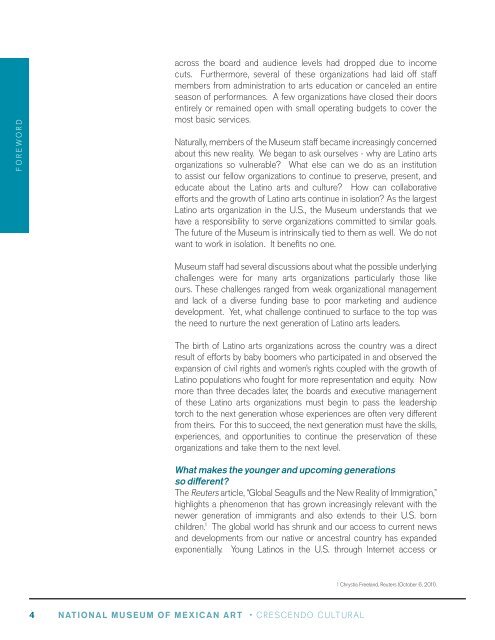Crescendo Cultural
Crescendo Cultural - National Museum of Mexican Art
Crescendo Cultural - National Museum of Mexican Art
- No tags were found...
Create successful ePaper yourself
Turn your PDF publications into a flip-book with our unique Google optimized e-Paper software.
tAb L e F oreW oF ContentsorDacross the board and audience levels had dropped due to incomecuts. Furthermore, several of these organizations had laid off staffmembers from administration to arts education or canceled an entireseason of performances. A few organizations have closed their doorsentirely or remained open with small operating budgets to cover themost basic services.naturally, members of the Museum staff became increasingly concernedabout this new reality. We began to ask ourselves - why are Latino artsorganizations so vulnerable? What else can we do as an institutionto assist our fellow organizations to continue to preserve, present, andeducate about the Latino arts and culture? How can collaborativeefforts and the growth of Latino arts continue in isolation? As the largestLatino arts organization in the U.s., the Museum understands that wehave a responsibility to serve organizations committed to similar goals.the future of the Museum is intrinsically tied to them as well. We do notwant to work in isolation. it benefits no one.Museum staff had several discussions about what the possible underlyingchallenges were for many arts organizations particularly those likeours. these challenges ranged from weak organizational managementand lack of a diverse funding base to poor marketing and audiencedevelopment. Yet, what challenge continued to surface to the top wasthe need to nurture the next generation of Latino arts leaders.the birth of Latino arts organizations across the country was a directresult of efforts by baby boomers who participated in and observed theexpansion of civil rights and women’s rights coupled with the growth ofLatino populations who fought for more representation and equity. nowmore than three decades later, the boards and executive managementof these Latino arts organizations must begin to pass the leadershiptorch to the next generation whose experiences are often very differentfrom theirs. For this to succeed, the next generation must have the skills,experiences, and opportunities to continue the preservation of theseorganizations and take them to the next level.What makes the younger and upcoming generationsso different?the reuters article, “Global seagulls and the new reality of immigration,”highlights a phenomenon that has grown increasingly relevant with thenewer generation of immigrants and also extends to their U.s. bornchildren. 1 the global world has shrunk and our access to current newsand developments from our native or ancestral country has expandedexponentially. Young Latinos in the U.s. through internet access orfrequent plane flights can more easily learn and enjoy their heritage,culture, history, music and art than previous generations. Moreover,they have increasing and up-to-date access to news, music, dramas,documentaries, and comedies in spanish with the rise of broadcast,cable and satellite networks. the new reality of immigration has indeedmade nations more than just physical places but a vast and growingnetwork of people and ideas.Latinos in their teens, twenties, and thirties are also different from theirparents, grandparents and great-grandparents in other significant ways.racism continues to exist but generally it is not as blatant as it wasa generation before. instead racism is hidden within existing powerstructures and this extends to the arts world. increasingly, Latinos interactsocially with individuals outside of their ethnic groups as they attendschool and begin to work. Many young Latinos have benefited from thesacrifices that their parents or previous generations fought for in termsof access to education, housing, and career opportunities. in the pastdecade as Latinos have become the largest people of color populationin the U.s., they have witnessed the visible growth of their communitiesand neighborhoods. Furthermore in many regions and cities across theU.s., Latinos are the majority or comprise sizeable populations.today Latinos can maintain their cultural traditions and adopt Americancultural practices with a freedom and ease that previous generations ofethnic immigrants could only dream to attain. U.s. society has begun toshift from the melting pot model to a salad bowl model – where manycultures and groups reside in this country and have the potential tosucceed while being perceived as American also. Latinos do not have toassimilate to succeed in the U.s. or lose their language, culture, or identity.even with these changes, the reality for Latinos in the U.s. is far fromperfect. We must acknowledge that much more is needed to assistthe socio-economic and political development and growth of Latinocommunities across the U.s. Latino arts and culture can play afundamental part in shaping the dialogue and moving towards a morepromising future for everyone.Arguments have been made that Latino cultural institutions are notneeded or soon will not be needed. opponents argue that there aretoo many ethnic-specific or cultural-specific institutions – why shouldthey be supported along with the other arts organizations that are notethnic-specific? these challenges are made to ethnic-specific artorganizations because opponents may not understand or fully appreciatethe benefits of these institutions or the value of cultural identity and art1 Chrystia Freeland, reuters (october 6, 2011).4 NATIONAL MUSEUM OF MEXICAN ART • CresCenDo CULtUrAL NATIONAL MUSEUM OF MEXICAN ART • CresCenDo CULtUrAL 5



